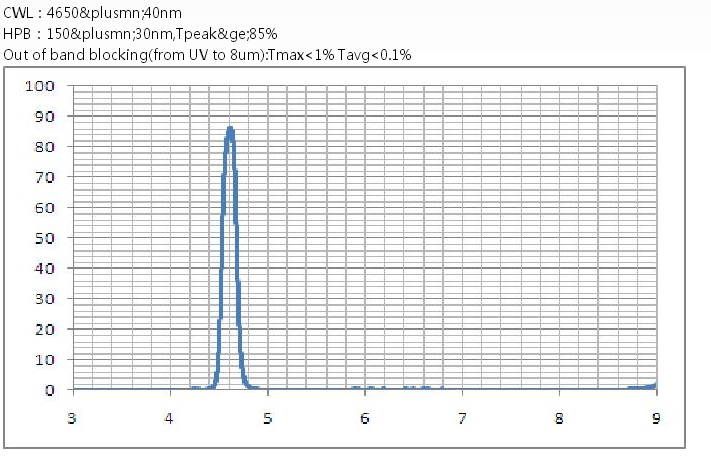
Description
1 Features
- Ultra-Narrow Band: These infrared filters are engineered to precisely isolate specific wavelengths, offering high selectivity in detection applications.
- High Transmission: The filters ensure excellent transmission of the targeted wavelengths while maintaining deep blocking of undesired wavelengths, ensuring clarity and precision.
- Sharp Slope: The filters feature a sharp slope, facilitating efficient wavelength isolation and minimizing unwanted signal interference.
- High Contrast: The superior contrast performance makes these filters ideal for various precision applications.
- Wide Application Range: These filters are widely used in environmental, security, and industrial applications, particularly for detecting gases like CO2, CH4, and others.
- General Description
Infrared filters are essential optical components used for isolating specific infrared wavelengths. They function by selectively transmitting light within a narrow band while reflecting or blocking out unwanted wavelengths. These filters are optimized for a variety of industrial and environmental monitoring systems, including detection systems for gases such as CO2, H2O, and CH4. They also play a crucial role in thermography systems, where detecting minute changes in infrared wavelengths is necessary for accurate temperature measurement.
The filters are available with tailored specifications to meet the needs of various applications. They are engineered for high durability and performance in demanding conditions, making them suitable for both scientific research and industrial uses. The precision coating ensures minimal distortion and maintains high transmission efficiency even at longer wavelengths, while blocking unwanted radiation effectively.
- Spectrum Transmission Curves
The transmission characteristics of the infrared filters are typically presented in the form of plots showing transmission versus wavelength. These curves depict the percentage of light passing through the filter across a wide range of wavelengths, highlighting the narrow bands where transmission is maximized. Custom wavelength ranges can be manufactured on request to suit specific detection needs.
Note: For customized spectral ranges or specific filter designs, SOT provides consultation and tailored solutions based on the customer’s precise requirements.
2830nm


3420-3970nm

3400-4000nm

3520-4030nm

4650nm

5360nm

8200nm

8800nm

9360nm


4. Coating Quality
SOT infrared filters undergo rigorous testing and quality assurance processes to ensure that they meet high industry standards.
- Adhesion Test: Compliant with MIL-C-675C military standards. The adhesion test involved applying tape that meets LT-90 specifications to the lens film. After three vertical removals, no blistering or peeling was observed.
- Temperature Test: Samples are tested between -62±1°C and 71±1°C per MIL-C-675C specifications. After maintaining room temperature conditions, no film detachment was observed.
- Abrasion Resistance: In line with MIL-C-675C and CCC-C-440 standards, the film underwent abrasion testing with gauze, showing no damage after 25 applications with a force of 1.0 lbs.
- Humidity Test: The samples were exposed to 95-100% humidity for 24 hours at 49±2°C, and no degradation or defects were found.
- Solvent and Cleaning: The filters were exposed to acetone and alcohol for cleaning, with no peeling or scratches after cleaning with alcohol-soaked cotton cloth.
- Salt Spray Test: After 100 hours of exposure in a 5% saltwater environment at 35°C, no degradation of the film was detected.
5. Standard Specifications
| Specification | Details |
| CWL (Center Wavelength) | Customizable (standard range: 3.40µm to 10.6µm) |
| Transmission | >85% |
| Blocking | Deep blocking, typically OD3 and higher |
| Thickness | 6mm (mounted) |
| Material | JGS1, K9, Quartz (custom material options available) |
| Wavelength Range | 3.40µm to 16.0µm |
| FWHM (Full Width at Half Maximum) | 180-300nm |
6. General Applications and Examples
Infrared filters are widely used across a variety of industries where detecting specific infrared wavelengths is critical. Some of the most common applications include:
- Environmental Monitoring: Used for detecting gases like CO2, CH4, H2O, and more in environmental systems for climate change studies and pollution control.
- Security Systems: In infrared surveillance systems to detect the presence of specific gases or temperature variations.
- Thermography Systems: These filters allow for precise infrared thermography, ensuring high-quality temperature measurements in industrial, medical, and military applications.
- Avionics: Used in advanced infrared detection systems for avionics and aerospace applications.
Custom solutions for specific gas detection, wavelength ranges, or transmission specifications can be provided upon request.
7. SOT Strengths and Capabilities
Shape Optics Technologies Pte Ltd (SOT) specializes in providing high-quality optical components that cater to the diverse needs of research, industrial, and medical applications. SOT is recognized for its expertise in designing custom infrared filters, delivering products that meet stringent performance requirements. With advanced manufacturing techniques and quality assurance practices, SOT ensures that all filters offer optimal durability, efficiency, and precision. Their commitment to customer satisfaction extends through tailored solutions that meet specific application needs, helping clients improve operational efficiency.
8. Standard Products
| CWL (µm) | Tpeak | FWHM | Blocking | Material | Part Number |
| 3.40±0.034 | 85% | 140±20nm | OD3@UV-11µm | JGS1 | IRF-340-01 |
| 4.26±0.042 | 85% | 180±20nm | OD3@UV-11µm | K9 | IRF-426-01 |
| 5.33±0.053 | 85% | 300±40nm | OD3@UV-11µm | K9 | IRF-533-01 |
| 7.30±0.073 | 85% | 180±20nm | OD3@UV-11µm | JGS1 | IRF-730-01 |

